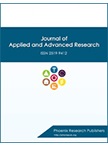Prospects and Present Status and of Entomopathogenic Nematodes (Steinernematidae and Heterorhabditidae) in Nepal
DOI:
https://doi.org/10.21839/jaar.2019.v4i1.261Abstract
Naturally occurring entomopathogenic nematodes(EPN) and their symbiotic bacteria are important biotic factor in suppression of insect pest populations in soil and cryptic habitats. These nematodes can control pests due to their mutualistic association with bacteria that kill the hosts by septicemia and make the environment favorable for EPN development and reproduction.The virulent species of EPN can commercially be mass produced as biological control agents all over the world. Nepal has a great potential to exploit these beneficial nematodes for the control of insect pests. Exploration of indigenous EPN is receiving attention around th eworld. Numerous surveys conducted worldwide have detected many indigenous isolates. Altogether 115 species of EPN (97 of Steinernema and 18 of Heterorhabdits species) have been reported so far worldwide. However, very limited research on EPN in Nepal has been done with 29 species only with some new species. Hence,the isolation and description of the native efficacious species and populationsof EPN is the need of the hour,not only from a biodiversity view point but also from an environmental and biological control perspective.Thei dentification of EPNs, adapted to environmental and climatic conditions of cultivated areas, is important for sustainable pest suppression in integrated management programs in agricultural areas of Nepal. This article provides an overview of recent development on EPN research and evaluates their potential for use and exploitation in Nepal.





 .
.